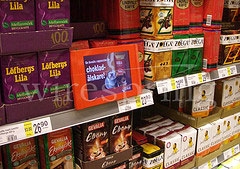
Although retail sectors vary widely in terms of average ticket, customer loyalty, and frequency of customer visits, virtually every retailer can benefit from improving the shopping experience and making employees more productive. Digital signage and connected devices are powerful tools that can improve the in-store experience, reduce the load on your customer service staff and even provide a supplementary revenue stream for your stores. Some popular applications include:
Smartphones and Tablets: Using their phone or tablet PC, shoppers can view product demonstrations, testimonial videos, and product reviews to help them make the right purchasing decision.
In-Store Advertising and Dynamic POP: Advertising-driven digital signage networks let advertisers buy screen time in order to tell customers about their products and thus drive more sales at the point-of-decision. The size and placement of screens (from tiny shelf-edge displays to giant projection models), types of content, and other attributes can vary quite a bit, but the most successful networks seem to be those that treat the screen time just like any other in-store medium. That is, digital signage is a dynamic form of point-of-purchase (POP) advertising that can be bought by marketers, and used to reach customers while they are selecting products on the sales floor.
In-Store TV and Radio Networks: Use ambient audio, video displays, or a combination of both to tell customers about featured products, reinforce why they should be shopping with you, and make the shopping experience more enjoyable. In some cases, this programming is combined with carefully selected songs, music videos, or even news and other third-party programming to help keep the content fresh, interesting, and relevant to the audience.
Product Information and Guided Selling: With many product decisions becoming increasingly complex, product info and guided selling kiosks let customers choose the attributes that matter the most to them, and then view only those products that match what they're looking for. These systems are especially well-suited for digital cameras, mobile phones, and other complex products, although they can be successful in other visual merchandising applications as well. Assisted selling kiosks are a variation on the interactive merchandising concept, but are designed for employees to use in assisting customers make a selection. Since the product info is stored centrally, these kiosks help employees deliver accurate and consistent product information.
Wayfinding Systems, Product Locators, and Price Check Stations: This type of kiosk helps customers find their way around the store and locate products. In highly task-oriented stores like pharmacies, a wayfinding kiosk that helps shoppers find what they're looking for will typically lead to more browsing and impulse purchases. Similarly, price checking kiosks build upon the classic price checker by letting customers scan a product and view pricing info, while also delivering up-sell and cross-sell information, product reviews, and more. These devices can either be stand-alone, or integrated into a general purpose retail or grocery kiosk.
Coupon Distribution, Loyalty Programs, and Customer Satisfaction: Electronic couponing and loyalty kiosks let customers browse through available promotions and select the ones that that match their interests. Similarly, survey kiosks provide a way for customers to rate the retail experience and provide meaningful data for future improvements. When used properly, these loyalty, survey, and coupon kiosks can be an excellent source of data for enterprise CRM and loyalty systems, while helping enroll more shoppers into customer loyalty card programs.
Product Line Extension: Multi-channel retailers often sell many more SKUs online or via catalog than they carry in stores, so interactive kiosks let customers browse and order these items right from the sales floor. These kiosks can also offer additional sizes and colors that aren't carried in the store.
Gift Card Sales and Refill: Allow customers to purchase and refill their gift cards from a self-service kiosk. In some cases, these gift card kiosks can also sell and recharge gift cards that are issued by partners or affiliated companies, helping create a new revenue stream for convenience stores and other host retailers.
Gift Registry: Kiosks for gift, bridal, and baby registries let customers create their own registry, or browse for products in an existing registry. Multichannel retailers will typically tie the kiosks to a larger gift registry system that tracks their website and phone orders as well. As a result, a couple could then create a wedding registry online and have it appear instantly on in-store kiosks, or vice versa.
Employee Training and Skills Assessment: Use digital signage to display employee training videos, safety bulletins, and other corporate messages before and after regular store hours. Interactive kiosks can also be used to give employees a self-guided way to view training materials and complete knowledge testing afterwards.
Job Application and HR Kiosks: Let prospective employees use a secure hiring kiosk to apply for job openings and electronically sign employment documents, reducing paperwork and protecting the privacy of their information. For existing staff members, employment kiosks let them update their address or other personal details, request days off, and check benefits information.
Here are some articles and tips that you might enjoy:

